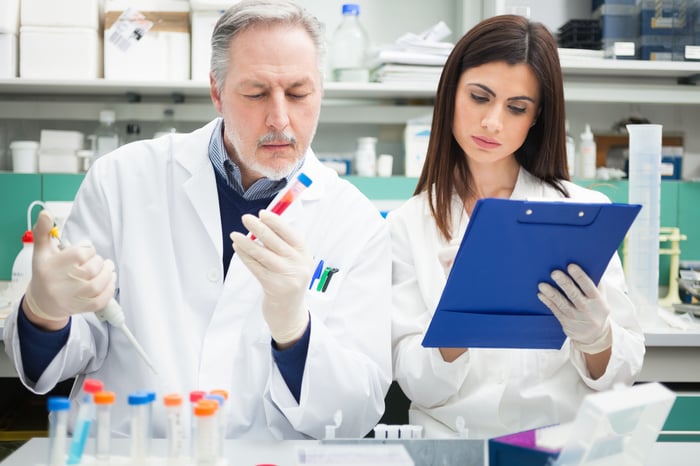AstraZeneca (AZN -2.38%) began the week with an eye-popping deal for a potential new cancer drug in a relatively early stage of development. The big pharma will hand its favorite collaboration partner, Daiichi Sankyo (DSNKY -2.41%), a whopping $1 billion upfront to develop and commercialize DS-1062, an experimental treatment for lung and breast cancer currently in phase 1 trials.
In addition to a gigantic up-front payment, AstraZeneca could pay its Japanese collaboration partner up to $5 billion in milestone payments. AstraZeneca had lots of reasons to make a confident bet on a program that had been flying under the radar. Here are four of the big ones investors should understand.

Image source: Getty Images.
1. A winning track record
AstraZeneca's latest collaboration deal with Daiichi Sankyo is the second largest up-front payment offered for a single clinical-stage cancer drug. The largest was a $1.35 billion payment AstraZeneca gave Daiichi Sankyo for rights to Enhertu, which was in phase 3 development at the time.
Late last year, AstraZeneca shareholders breathed a sigh of relief when Enhertu shrank tumors for 60.9% of patients and prevented most patients from showing signs of disease worsening for more than 14.8 months. In December, Enhertu earned approval from the FDA to treat a large population of patients with HER2-positive breast cancer, and sales of the drug are expected to top $2.5 billion annually at its peak.
2. Familiar technology
Enhertu and DS-1062 belong to an increasingly common class of cancer therapies called antibody-drug conjugates (ADCs). These are proteins armed with lethal doses of chemotherapy that only explode after entering cancer cells coated with specific proteins associated with cancer.
In 2011, Seattle Genetics (SGEN) launched the first ADC in the U.S., a Hodgkin lymphoma treatment called Adcetris. Seattle Genetics expects Adcetris sales to reach between $675 million and $700 million this year, and DS-1062 could go a lot further as a treatment for much larger patient populations.
3. Big patient populations
DS-1062 targets TROP2 receptors, which are found on tumors of a majority of patients with non-small cell lung cancer (NSCLC), and around 80% of patients with triple-negative breast cancer (TNBC). Lung cancer isn't the most common malignancy, but it's expected to claim the lives of around 135,000 Americans in 2020.
The five-year survival rate for patients with lung cancer that has already spread is a dismal 6% and therapies that can boost these odds have been incredibly successful. In 2019, Keytruda from Merck (MRK -1.75%) earned approval to treat newly diagnosed NSCLC patients, and sales of the therapy soared 45% year over year to an annualized $13.1 billion during the first three months of 2020.

Image source: Getty Images.
4. A well-understood target
AstraZeneca knows that an approval to treat NSCLC could be worth billions in annual revenue, and the company also knows that TROP2 is a worthwhile target. This April, the FDA approved another ADC that targets TROP2 receptors called Trodelvy from Immunomedics (IMMU) after it shrank tumors for 33.3% of TNBC patients in a pivotal study.
AstraZeneca and Daiichi Sankyo believe DS-1062 will come from behind and outperform Trodelvy as a treatment for TNBC, or at least pass Immunomedics' drug on the way to treat the large NSCLC population. Last June, Daiichi Sankyo reported tumor shrinkage for 10 out of 39 advanced-stage NSCLC patients that had already relapsed after multiple previous lines of treatment.
Full steam ahead
First-quarter oncology sales soared 33% to $2.5 billion and this successful segment now contributes 40% of AstraZeneca's total revenue. First-quarter sales of the company's highly successful lung cancer treatment, Tagrisso, jumped 56% year over year to an annualized $3.9 billion.
In late 2019, the FDA approved Calquence, a Bruton's tyrosine kinase inhibitor similar to Imbruvica, for the treatment of the most common form of leukemia. By 2025, annual Calquence sales are expected to reach $2 billion. AstraZeneca had plenty of reasons to jump at DS-1062, but it hardly needs to live up to expectations for the company to continue reporting impressive sales growth for years to come.





